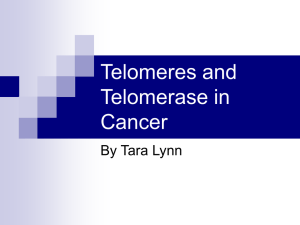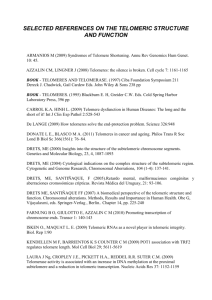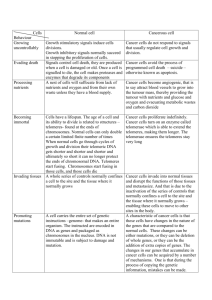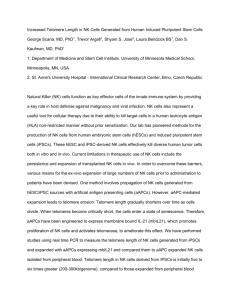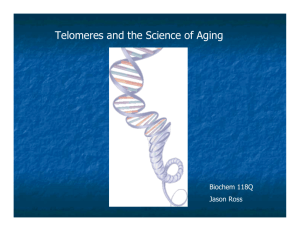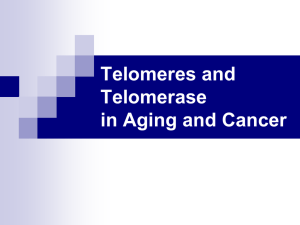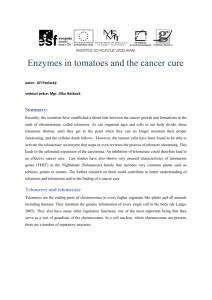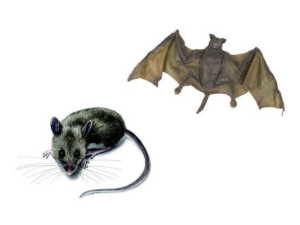Telomeres and telomerase: biological and clinical
advertisement
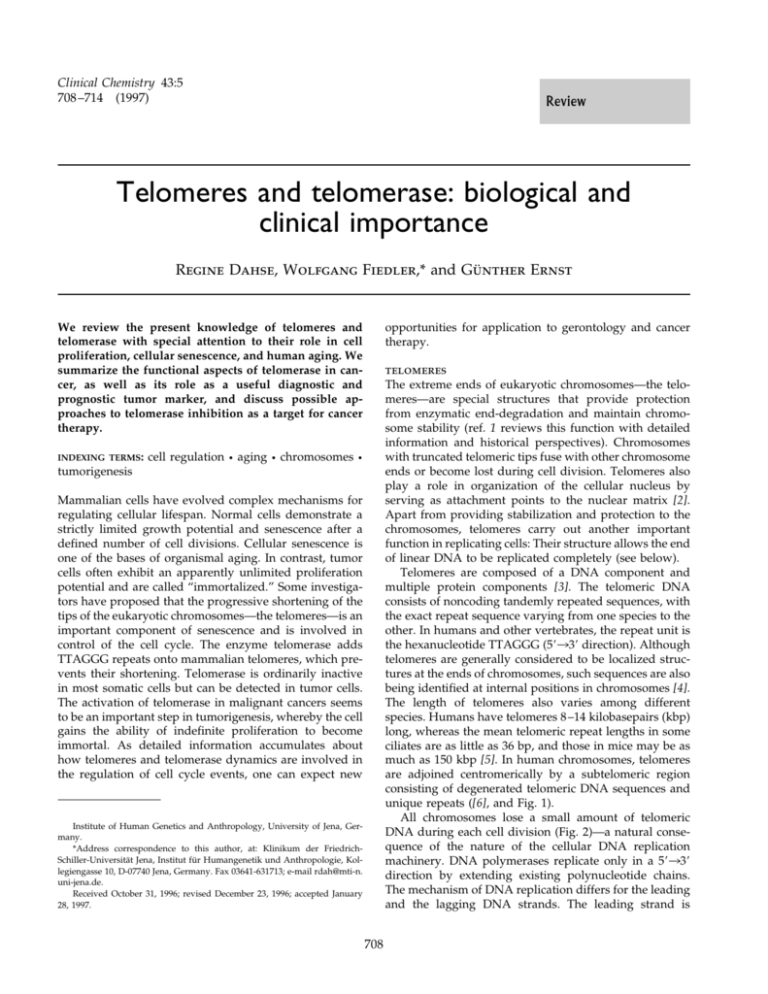
Clinical Chemistry 43:5 708 –714 (1997) Review Telomeres and telomerase: biological and clinical importance Regine Dahse, Wolfgang Fiedler,* and Günther Ernst We review the present knowledge of telomeres and telomerase with special attention to their role in cell proliferation, cellular senescence, and human aging. We summarize the functional aspects of telomerase in cancer, as well as its role as a useful diagnostic and prognostic tumor marker, and discuss possible approaches to telomerase inhibition as a target for cancer therapy. INDEXING TERMS: cell regulation • aging • chromosomes opportunities for application to gerontology and cancer therapy. telomeres The extreme ends of eukaryotic chromosomes—the telomeres—are special structures that provide protection from enzymatic end-degradation and maintain chromosome stability (ref. 1 reviews this function with detailed information and historical perspectives). Chromosomes with truncated telomeric tips fuse with other chromosome ends or become lost during cell division. Telomeres also play a role in organization of the cellular nucleus by serving as attachment points to the nuclear matrix [2]. Apart from providing stabilization and protection to the chromosomes, telomeres carry out another important function in replicating cells: Their structure allows the end of linear DNA to be replicated completely (see below). Telomeres are composed of a DNA component and multiple protein components [3]. The telomeric DNA consists of noncoding tandemly repeated sequences, with the exact repeat sequence varying from one species to the other. In humans and other vertebrates, the repeat unit is the hexanucleotide TTAGGG (59339 direction). Although telomeres are generally considered to be localized structures at the ends of chromosomes, such sequences are also being identified at internal positions in chromosomes [4]. The length of telomeres also varies among different species. Humans have telomeres 8 –14 kilobasepairs (kbp) long, whereas the mean telomeric repeat lengths in some ciliates are as little as 36 bp, and those in mice may be as much as 150 kbp [5]. In human chromosomes, telomeres are adjoined centromerically by a subtelomeric region consisting of degenerated telomeric DNA sequences and unique repeats ([6], and Fig. 1). All chromosomes lose a small amount of telomeric DNA during each cell division (Fig. 2)—a natural consequence of the nature of the cellular DNA replication machinery. DNA polymerases replicate only in a 59339 direction by extending existing polynucleotide chains. The mechanism of DNA replication differs for the leading and the lagging DNA strands. The leading strand is • tumorigenesis Mammalian cells have evolved complex mechanisms for regulating cellular lifespan. Normal cells demonstrate a strictly limited growth potential and senescence after a defined number of cell divisions. Cellular senescence is one of the bases of organismal aging. In contrast, tumor cells often exhibit an apparently unlimited proliferation potential and are called “immortalized.” Some investigators have proposed that the progressive shortening of the tips of the eukaryotic chromosomes—the telomeres—is an important component of senescence and is involved in control of the cell cycle. The enzyme telomerase adds TTAGGG repeats onto mammalian telomeres, which prevents their shortening. Telomerase is ordinarily inactive in most somatic cells but can be detected in tumor cells. The activation of telomerase in malignant cancers seems to be an important step in tumorigenesis, whereby the cell gains the ability of indefinite proliferation to become immortal. As detailed information accumulates about how telomeres and telomerase dynamics are involved in the regulation of cell cycle events, one can expect new Institute of Human Genetics and Anthropology, University of Jena, Germany. *Address correspondence to this author, at: Klinikum der FriedrichSchiller-Universität Jena, Institut für Humangenetik und Anthropologie, Kollegiengasse 10, D-07740 Jena, Germany. Fax 03641-631713; e-mail rdah@mti-n. uni-jena.de. Received October 31, 1996; revised December 23, 1996; accepted January 28, 1997. 708 Clinical Chemistry 43, No. 5, 1997 709 telomerase Fig. 1. Schematic illustration of a human metaphase chromosome. replicated continually. To replicate the lagging strand, DNA polymerization starts from several RNA primers, which are elongated to create DNA fragments termed Okazaki fragments. These RNA primers are finally degraded and replaced by DNA sequences. Removal of the terminal RNA primer on the lagging strand leaves a gap that ordinarily is filled in by extension of the next Okazaki fragment. Because there is no template for the “last” Okazaki fragment beyond the 59 end of the chromosome, one strand cannot be synthesized to its very end. This so-called end replication problem predicts the progressive reduction of chromosomal DNA at the 39 ends during multiple cell cycles. The loss of genomic sequences at each replication cycle can be compensated by addition of terminal sequences through various mechanisms: e.g., in yeast by recombination events [7] or in Drosophila by transposition [8]. Moreover, organisms possess the ability to transfer species-specific terminal sequences onto DNA: Shampay et al. [9] demonstrated that telomeric DNA from Tetrahymena introduced into yeast became elongated with yeast telomeric sequences. The crucial experiments came from Greider and Blackburn [10, 11], who detected in Tetrahymena extracts an activity that added telomeric repeats to single-stranded telomeric DNA oligonucleotide primers; they also found that this process is inactivated by treating the extract with a RNA-degrading enzyme. Therefore, this RNA-dependent activity, named terminal transferase or telomerase, was found to be a ribonucleoprotein complex that utilizes sequences of its own RNA component as a template for the de novo synthesis of telomeric DNA sequences. Both RNA and several protein components of telomerase are needed for enzymatic activity. Recently, the telomerase RNAs of yeasts and humans have been cloned [12, 13]. The large size of human telomerase RNA and its molecular mass (.300 kDa) suggest that the human telomerase enzyme complex has more than two protein subunits [14]. The telomerase proteins seem to have structural importance by binding dNTPs (deoxynucleoside triphosphates) or DNA sequences. Their catalytic tools provide the functional groups that catalyze the addition of nucleotides to the 39 end. The basic telomerase reaction mechanisms are primer recognition and base pairing, nucleotide addition, and translocation. Accordingly, Kim et al. [15] developed an assay for testing telomerase activity in cell extracts. Based on identification of telomerase mechanisms and properties, the telomere repeat amplification protocol includes preparation of a protein extract by cell lysis and adding a primer and dNTPs. If telomerase is active in the extract, it elongates the added template, and the reaction product is amplified by PCR. Because telomerase pauses after synthesis of a set of six nucleotides, amplification products separated on a polyacrylamide gel look like a 6-bp nucleotide ladder. Using this amplification protocol, one can detect 1 telomerase-positive cell among 10 000 cells. telomeres, telomerase, cellular aging, and immortality Fig. 2. The so-called end replication problem predicts the continual shortening of telomeres during multiple cell cycles, although the loss of chromosomal DNA can be compensated by the activity of the enzyme telomerase. Because the lost sequences of the telomeres at each replication cycle can be resynthesized by telomerase, the enzyme has essential functions for cell immortalization (Fig. 2). More than 20 years ago, Olovnikov showed that the loss of telomere sequences because of the end replication problem might explicate a possible role in regulating cellular lifespan [16]. Telomere shortening was ascribed a function, i.e., to act like a mitotic clock that counts the number of cell divisions and limits endless cell proliferation by signaling entry into senescence [16, 17]. Ac- 710 Dahse et al.: Telomeres and telomerase reviewed cording to this telomere theory, a small amount of telomeric DNA is lost with each round of cell division. When the telomere length is reduced to a critical point, a signal is given to stop further cell division, the hallmark of cellular senescence. Replicating somatic cells in vitro lose 30 –200 bp of telomeric sequences per population doubling, or ;105–50 bp per year in vivo [18]. Telomere length and stability in adult somatic cells differ from those in fetal and germline cells. In the somatic tissues of an individual, the telomeres are noticeably shorter than in sperm cells, and lengths decrease with increasing age of the individual. On the other hand, telomeres in sperm maintain their length independently of increasing individual age [19]. In cultured cells, the loss of telomeric DNA depends on the number of cell divisions, and Allsopp et al. have noted that telomere length is a useful predictor of the residual proliferative capacity of cells [19]. In this context, the question arises as to whether one could achieve unlimited replication capacity and immortality in somatic cells if telomere length could be maintained. Counter et al. [20] transfected normal human embryonic kidney cells with Simian Virus 40 tumor antigen (SV 40 T), forming a tumor virus protein that extended the lifespan of cultured cells. The transfected cells divided and entered a point of crisis, in which most of the cells died; only some cells became immortal. During the period of cell division, the telomeres shortened continually and no telomerase activity could be detected. Those cells that survived the crisis point and became immortal had reactivated telomerase and stabilized their telomeres. This means that even somatic cells can gain the ability of endless replication if telomere length is maintained and (or) the enzyme telomerase is activated. Cells in culture are thought to stop dividing because of activation of an antiproliferative mechanism termed “mortality stage 1” (M1). The stimulus for the induction of M1 may be DNA-damage signals from the altered expres- sion of subtelomeric regulatory genes or from a critical shortened telomere. P53 and the retinoblastoma gene product pRb are involved in the execution of M1. One hypothesis for the induction of M1 postulates the following: (a) a single chromosome denuded of telomeric repeats produces a DNA-damage signal, which (b) induces p53 and p21; (c) p21 inhibits the cyclin-dependent kinases, which then (d) are prevented from phosphorylating pRb; (e) the presence of unphosphorylated pRb coupled with other actions of p53 and p21 results in the M1 arrest [21]. If these cell cycle regulators are mutated or blocked, the cells continue to divide and thus the telomeres continue to shorten. Cells divide until a second independent block in proliferation is reached, termed “mortality stage 2” (M2). The M2 mechanism is probably induced when so few telomere repeats remain that the unprotected chromosomal ends block further proliferation. The M2 block might be overcome in some cells by reactivation of telomerase, the repair of chromosome ends, the stabilization of telomere length, and the generation of an immortal cell clone ([21], and Fig. 3). The findings concerning telomerase activity in various human tissues are in accord with the differences in the telomere length described above: The enzyme is detectable in germline cells, but not in most postnatal somatic tissues (Table 1). Telomerase-independent mechanisms may also exist that stabilize telomere length. Murnane et al. [22] and Bryan et al. [23] reported telomere elongation in immortal human cells without detectable telomerase activity. So far, it is not clear whether telomere stabilization in these cells is achieved by the above-mentioned recombination or transposition events, or whether transformed cells may develop alternative mechanisms to circumvent any possible telomerase inhibition. The present knowledge about the role of telomeres and telomerase in cellular senescence carries scientists a step forward toward understanding the phenomenon of hu- Fig. 3. Hypothetical model of cellular immortalization. Clinical Chemistry 43, No. 5, 1997 Table 1.Mean telomere lengths and telomerase activity in various human cells and tumors. Human cell line/tissue Sperm (donor: 20 years) Sperm (donor: 68 years) Fetal kidney Fetal liver Colon mucosa Colon cancer Skin tumor Breast tumor Lung tumor Kidney tumor Fetal fibroblasts in vitro Fibroblasts (71 years) in vitro Fetal fibroblasts in vivo Fibroblasts (93 years) in vivo Fibroblasts (9–14 years) Fibroblasts progeria patient (0–14 years) Fibroblasts Werner syndrome patient Mean telomere length, kbp Telomerase activitya 12 16 20 17 10 3–4 4–10 4–10 4–10 4–10 8.6 6.5 8.6 7.1 8.8 5.4 1 1 2 Unknown 2 1 1 1 1 1 2 2 2 2 2 Unknown 4.7 Unknown Source: [5]. a Present (1), absent (2). man aging—a process accompanied by an accumulation of various cytogenetic changes and an increasing deficiency in DNA repair mechanisms. Lindsey et al. [24] found that in patients with syndromes of accelerated aging [progeria (i.e., Hutchinson–Gilford syndrome) and Werner syndrome], the mean telomere lengths in cell cultures were considerably shorter than in normal individuals. These premature aging syndromes are characterized in progeria by growth retardation and accelerated degenerative changes of the cutaneous, musculoskeletal, and cardiovascular systems in young patients [25], and in Werner syndrome, for which recently the a candidate gene has been identified [26], by an early-onset and accelerated rate of development of major geriatric disorders such as atherosclerosis, diabetes mellitus, osteoporosis, and various neoplasms [27]. Recently, Kruk et al. [28] demonstrated that repair of DNA damage in telomeric regions decreases with age. Possibly this deficiency in telomeric repair is correlated with an age-related increase in genetic instability. telomeres, telomerase, and cancer The cell cycle includes the orderly sequence of events that ensure the faithful duplication of all the cellular components in their correct sequence and the partitioning of these components into two daughter cells. Two classes of genes and their protein products are used to accomplish this process: genes whose products are obligatory for progress through the cell cycle phases, and genes whose proteins act as checkpoints for monitoring the efficacy and completion of these obligatory events and stopping the progression through the cell cycle if conditions are not 711 satisfactory. The loss of cell cycle control generally leads to cell death but can also result in abnormal cells that continue to replicate and eventually form a tumor (for a review, see [29]). The theory of carcinogenesis suggests that unlimited cell proliferation is required for development of malignant disease, and cancer cells must attain immortality for progression to malignant states. As shown above, shortening of telomeres may contribute to the control of the proliferative capacity of normal cells, and the enzyme telomerase may be essential for unlimited cell proliferation. The length of telomeres in cancer cells depends on a balance between the telomere shortening at each cell cycle and the telomere elongation resulting from telomerase activity. Tumors with shorter telomeres than in the original tissue have been detected in many cancer types (for a review, see [30]). In neuroblastoma, endometrial cancer, breast cancer, leukemias, and lung cancer, a correlation between decreasing telomere lengths and an increasing severity of disease has been described [31–35]. Short telomeres seem to be a primary cause for karyotype instability in malignant cells. According to the abovedescribed theory of telomere dynamics during cell progression, tumor cells with shortened telomeres can be considered to have undergone many cell divisions, with an accumulation of various genetic alterations. After a point of critical telomere shortening, telomerase might be reactivated to stabilize or elongate the telomeric DNA. Tumors with telomeres just as long as or even longer than in the original tissue seem to be rarer but have been described in some human malignant tissues, e.g., intracranial tumors, basal cell carcinomas of the skin, and renal cell carcinomas [36 –39]. There are two possible explanations for this phenomenon: Either an activated telomerase has elongated the once-shortened telomeres back to former length, or the tumor cells have not yet undergone enough cell divisions to induce significant shortening of telomeres. Telomerase is absent in most human somatic cells (see Table 1) but, as Rhyu reports [40], was detected in ;85% of 400 tumor tissue samples. Low amounts of telomerase activity in normal human tissues were found only in hematopoietic progenitor cells and activated T- and Blymphocytes [41]; in germ cells, ovaries, and testes [42]; and in physiologically regenerating epithelial cells [43]. Results from examinations of normal tissues and benign cancers as well as malignant primary and metastatic tumors permit several conclusions. As in most normal tissues, telomerase activity is not expressed in somatic tissues adjacent to the tumor tissue. Accordingly, telomerase activity has proved to be a reliable marker for detecting tumor cells in resection margins. In benign and premalignant tumors, including breast fibrocystic disease and fibroadenomas, benign prostatic hyperplasia, colorectal adenomas, anaplastic astrocytomas, and benign meningiomas and leiomyomas, in general no telomerase activity was detected; however, it was 712 Dahse et al.: Telomeres and telomerase reviewed found in malignant tumor stages [44 – 47]. In this way, telomerase activity is associated with the acquisition of malignancy. The detection of telomerase activity at preneoplastic or benign growth stages may signify disease progression and be of diagnostic value. For example, telomerase activity has been found in some cases of benign prostate hyperplasia and of benign giant tumors of the bone [45, 48]—all tissues that may progress to malignant tumors. As shown by Hiyama et al. [44] in breast cancer, telomerase provides a useful diagnostic tumor marker: Among samples obtained by fine-needle aspiration, 14 of 14 patients whose aspirates contained detectable telomerase activity, and who subsequently underwent surgery, were confirmed to have breast cancer. Certain tumor types, such as neuroblastoma, display a lower telomerase activity in early-stage cancers, whereas expression in late-stage cases is higher [49]. Neuroblastomas of a special stage (stage IV), which had short telomeres and no or weak telomerase activity, tended to regress spontaneously [49]—possible proof of a correlation between an enzyme activity too weak to remain in an immortal tumor status and a favorable outcome for the patient. Another example of telomerase activity in cancer diagnosis and as a prognostic indicator of clinical outcome is the results found in gastric cancers. Hiyama et al. [50] showed that the survival rate of patients with tumors with detectable telomerase activity in their study was shorter than that of those without telomerase activity. Although a reliable tumor marker, telomerase activity is not an all-or-none phenomenon. To understand the regulation of telomerase during tumorigenesis, Greider et al. analyzed the concentrations of telomerase RNA components and discussed the differential regulation of enzyme activity according to the concentration of the RNA component [51, 52]. Further prospective and retrospective clinical studies must be carried out to assess the validity of telomere dynamics and telomerase as a diagnostic or prognostic marker in many cancer types. telomerase as a target for anticancer therapy These findings suggest that reactivation of telomerase may be an obligate event in cell immortalization and in most instances of tumorigenesis. Any kind of inhibition of the enzyme should therefore lead to resumption of telomere shortening and might activate the cellular senescence pathway. The fact that telomerase is absent and not required in most human somatic tissues but is necessary for tumor growth should make this enzyme an ideal target for anticancer therapy. One of the greatest challenges in cancer therapy is to achieve a high therapeutic effect by maximizing the desired reactions and minimizing the undesired sideeffects. Several conditions must be successfully fulfilled to achieve a beneficial antitumor effect in vivo: 1) Introduction of the antitumor agent into the majority and perhaps 100% of the tumor cells 2) The antitumor agent reaching the target 3) Tumor cell death 4) Acceptable toxicity to normal cells 5) Absence of a deleterious host immune response. One of the most hopeful approaches to achieving these goals is oligonucleotide-based gene therapy. The regulation of expression of genetic information by complementary pairing of sense and antisense nucleic acid strands has been termed “antisense.” It is now possible to design antisense DNA oligonucleotides or antisense RNAs that can pair with and functionally inhibit the expression of genes in a sequence fashion. This high degree of specificity has made antisense constructs attractive candidates for therapeutic agents [53]. Because the antisense sequences require chemical modifications to avoid destruction by nucleases and to form complexes for better delivery into the cell, peptide nucleic acids (PNAs) have been designed—with a charge-neutral, pseudo-peptide backbone of N-(2-aminoethyl)glycine units instead of a negatively charged deoxyribose-phosphate backbone [54]. Recently, Norton et al. [55] reported on PNAs that have a sequence complementary to the RNA component of human telomerase. They designed oligonucleotides that bind to the RNA molecule within the telomerase, which serves as the enzyme’s own internal telomere template. These molecules seem to be very specific and efficient inhibitors of telomerase in vitro. Further experiments with cell cultures and tumor models in mice will continue this path of investigation and could justify the optimism surrounding the telomerase hypothesis and its exploitation as a novel anti-cancer therapy. Several important unanswered questions remain. A possible therapeutic approach of telomerase to cancer patients would appear to be less toxic than conventional chemotherapy, which affects all dividing cells and has undesirable side effects. However, some normal somatic cells are telomerase-positive at baseline: human hematopoietic progenitor cells, germ cells (progenitors of sperm and oocytes), and activated T-and B-lymphocytes. Telomeric DNA in these cells would be lost during an “antitelomerase therapy.” Perhaps this loss could be buffered, because of the longer telomeres in these cells than in cancer cells and because of the lower division rate relative to tumor cells. Another problem is in the variability of telomere lengths among tumors. Telomerase inhibition seems to be useful only in malignant cells with short telomeres; tumor cells with long telomeres would require a prolonged treatment, with possible toxic side-effects. One should also consider that alternative pathways besides telomerase may exist for regulating telomere length. Many other issues remain to be resolved. Even if the causal relationship were clear between continually shrinking telomeres and cellular senescence on the one side and unlimited proliferation of cells that have stabilized their telomeres’ length by the enzyme telomerase on Clinical Chemistry 43, No. 5, 1997 the other, we still need to learn: Which genes encode telomerase components? Are telomeric RNA and proteins regulated at the transcriptional or posttranscriptional level? Does regulation of the RNA or of the protein components determine activity? Do internal cellular mechanisms exist to repress telomerase? Based on the present knowledge of telomeres and telomerase mechanisms, considerable efforts will have to be taken to answer these open questions and to make use of the new results for developing new diagnostic tools and therapeutic strategies. We are grateful to Scott K. Durum and Udo Junker, National Cancer Institute, Frederick, MD, for critical comments. References 1. Blackburn EH, Greider CW, eds. Telomeres. Cold Spring Harbor, NY: Cold Spring Harbor Laboratory Press, 1995:1–396. 2. de Lange T. Human telomeres are attached to the nuclear matrix. EMBO J 1992;11:717–24. 3. Greider CW. Telomere length regulation. Annu Rev Biochem 1996; 65:337– 65. 4. Katinka M, Bourgain F. Interstitial telomeres are hotspots for illegitimate recombination with DNA molecules injected into the macronucleus of Paramecium primaurelia. EMBO J 1992;11:725– 32. 5. Kalluri R. Telomere (telomerase) hypothesis of aging and immortalization. Indian J Biochem Biophys 1996;33:88 –92. 6. Brown W, MacKinnon P, Villasante A, Spurr N, Buckle VJ, Dobson MJ. Structure and polymorphism of human telomere-associated DNA. Cell 1990;63:119 –32. 7. Lundblad V, Blackburn E. An alternative pathway for yeast telomere maintenance rescues est1-senescence. Cell 1993;73:347– 60. 8. Biessmann H, Mason J. Genetics and molecular biology of telomeres [Review]. Adv Genet 1992;30:185–249. 9. Shampay J, Szostak J, Blackburn E. DNA sequences of telomeres maintained in yeast. Nature 1984;310:154 –7. 10. Greider C, Blackburn E. Identification of a specific telomere terminal transferase activity in Tetrahymena extracts. Cell 1985; 43:405–13. 11. Greider C, Blackburn E. The telomere terminal transferase of Tetrahymena is a ribonucleoprotein enzyme with two kinds of primer specificity. Cell 1987;51:887–98. 12. Singer M, Gottschling D. TLCI, template RNA component of Saccharomyces cerevisiae telomerase. Science 1994;266:404 –9. 13. Feng J, Funk W, Wang S, Weinrich S, Avilion A, Chiu C, et al. The RNA component of human telomerase. Science 1995;269:1236 – 41. 14. Morin GB. The structure and properties of mammalian telomerase and their potential impact on human disease. Sem Cell Dev Biol 1996;7:5–13. 15. Kim N, Piatyszek M, Prowse K, Harley C, West M, Ho P, et al. Specific association of human telomerase activity with immortal cells and cancer. Science 1994;266:2011– 4. 16. Olovnikov A. A theory of marginotomy. The incomplete copying of template margin in enzymatic synthesis of polynucleotides, and biological significance of the phenomenon. J Theor Biol 1973;41: 181–90. 713 17. Harley CB. Telomere loss, mitotic clock or genetic bomb? Mutat Res 1991;256:271– 82. 18. Harley CB. Telomeres and aging. In: Blackburn EH, Greider CW, eds. Telomeres. Cold Spring Harbor, NY: Cold Spring Harbor Laboratory Press, 1995:247– 63. 19. Allsopp R, Vaziri H, Patterson C, Goldstein S, Younglai E, Futcher A, et al. Telomere length predicts replicative capacity of human fibroblasts. Proc Natl Acad Sci U S A 1992;89:10114 – 8. 20. Counter C, Avilion A, LeFeuvre C, Stewart N, Greider C, Harley C, Bacchetti S. Telomere shortening associated with chromosome instability is arrested in immortal cells which express telomerase activity. EMBO J 1992;11:1921–9. 21. Wright W, Shay J. Time, telomeres and tumours. Is cellular senescence more than an anticancer mechanism? Trends Cell Biol 1995;5:293–7. 22. Murnane J, Sabatier L, Marder B. Telomere dynamics in an immortal cell line. EMBO J 1994;13:4953– 62. 23. Bryan T, Englezou A, Gupta J, Bacchetti S, Reddel R. Telomere elongation in immortal human cells without detectable telomerase activity. EMBO J 1995;14:4240 – 8. 24. Lindsey J, McGill N, Lindsey L, Green D, Cooke H. In vivo loss of telomeric repeats with age in humans. Mutat Res 1991;256: 45– 8. 25. Stables G, Morley W. Hutchinson–Gilford syndrome. J R Soc Med 1994;87:243– 4. 26. Pennisi E. Premature aging gene discovered. Science 1996;272: 193– 4. 27. Schulz V, Zakian V, Ogburn C, McKay J, Jarzebowicz A, Edland S, Martin G. Accelerated loss of telomeric repeats may not explain accelerated replicative decline of Werner syndrome cells. Hum Genet 1996;97:750 – 4. 28. Kruk P, Rampino N, Bohr V. DNA damage and repair in telomeres. Relation to aging. Proc Natl Acad Sci U S A 1995;92:258 – 62. 29. Cordon-Cardo C. Mutation of cell cycle regulators. Biological and clinical implications for human neoplasia [Review]. Am J Pathol 1995;147:545– 60. 30. Bacchetti S, Counter C. Telomeres and telomerase in human cancer [Review]. Int J Oncol 1995;7.423–32. 31. Hiyama E, Hiyama K, Yokoyama T, Ichikawa T, Matsuura Y. Length of telomeric repeats in neuroblastoma; correlation with prognosis and other biological characteristics. Jpn J Cancer Res 1992;83: 159 – 64. 32. Smith J, Yeh G. Telomere reduction in endometrial adenocarcinoma. Am J Obstet Gynecol 1992;167:1883–7. 33. Odagiri E, Kanda N, Jibiki K, Demura R, Aikawa E, Demura H. Reduction of telomeric length and c-erbB-2 gene amplification in human breast cancer, fibroadenoma and gynecomastia. Cancer 1994;73:2978 – 84. 34. Ohyashiki J, Ohyashiki K, Fujimura T, Kawakubo K, Shimamoto T, Iwabuchi A, Toyama K. Telomere shortening associated with disease evolution patterns in myelodysplastic syndromes. Cancer Res 1994;54:3557– 60. 35. Hiyama K, Hiyama E, Ishioka S, Yamakido M, Inai K, Gazdar A, et al. Telomerase activity in small-cell and non-small-cell lung cancers. J Natl Cancer Inst 1995;87:895–902. 36. Schmitt H, Blin N, Zankl H, Scherthan H. Telomere length variation in normal and malignant human tissues. Genes Chromosom Cancer 1994;11:171–177. 37. Nürnberg P, Thiel G. Weber F, Epplen J. Changes of telomere lengths in human intracranial tumors. Hum Genet 1993;91: 190 –2. 38. Wainwright J, Middleton PG, Rees JL. Changes in mean telomere length in basal cell carcinomas of the skin. Genes Chromosom Cancer 1995;12:45–9. 39. Dahse R, Fiedler W, Ernst G, Kosmehl H, Schlichter A, Schubert J, 714 40. 41. 42. 43. 44. 45. 46. 47. Dahse et al.: Telomeres and telomerase reviewed Claussen U. Changes in telomere lengths in renal cell carcinomas. Cell Mol Biol 1996;42:477– 85. Rhyu M. Telomeres, telomerase, immortality [Review]. J Natl Cancer Inst 1995;87:885–94. Hiyama K, Hirai Y, Kyoizumi S, Akiyama M, Hiyama E, Piatyszek M, et al. Activation of telomerase in human lymphocytes and hematopoietic progenitor cells. J Immunol 1995;155:3711–5. Wright W, Piatyszek M, Rainey W, Byrd W, Shay J. Telomerase activity in human germline and embryonic tissues and cells. Dev Genet 1996;18:173–9. Yasumoto S, Kunimura C, Kikuchi K, Tahara H, Ohji H, Yamamoto H, et al. Telomerase activity in normal human epithelial cells. Oncogene 1996;13:433–9. Hiyama E, Gollahon L, Kataoka T, Kuroi K, Yokoyama T, Gazdar AF, et al. Telomerase activity in human breast tumors. J Natl Cancer Inst 1996;17:116 –22. Sommerfeld HJ, Meeker A, Piatyszek M, Bova S, Shay J, Coffey D. Telomerase activity. A prevalent marker of malignant human prostate tissue. Cancer Res 1996;56:218 –22. Langford L, Piatyszek M, Xu R, Schold S, Shay J. Telomerase activity in human brain tumours. Lancet 1995;346:1267– 8. Chadeneau C, Hay K, Hirte H, Gallinger S, Bacchetti S. Telomerase activity associated with acquisition of malignancy in human colorectal cancer. Cancer Res 1995;55:2533– 6. 48. Schwartz H, Juliao S, Sciadini M, Miller L, Butler M. Telomerase activity and oncogenesis in giant cell tumors of bone. Cancer 1995;75:1094 –9. 49. Hiyama E, Hiyama K, Yokoyama T, Matsuura Y, Piatyszek M, Shay J. Correlating telomerase activity levels with human neuroblastoma outcomes. Nature Med 1995;1:249 –55. 50. Hiyama E, Yokoyama T, Tatsumoto N, Hiyama K, Imamura Y, Murakami Y, et al. Telomerase activity in gastric cancer. Cancer Res 1995;55:3258 – 62. 51. Blasco M, Rizen M, Greider C, Hanahan D. Differential regulation of telomerase activity and telomerase RNA during multi-stage tumorigenesis. Nature Genet 1996;12:200 – 4. 52. Avilion A, Piatyszek A, Gupta J, Shay J, Bacchetti S, Greider C. Human telomerase RNA and telomerase activity in immortal cell lines and tumor tissues. Cancer Res 1996;56:645–50. 53. Rossi J. Therapeutic antisense and ribozymes. Br Med Bull 1995;51:217–25. 54. Wittung H, Nielsen P, Buchardt O, Egholm M, Norden B. DNA-like double helix formed by peptide nucleic acid. Nature 1994;368: 561–3. 55. Norton J, Piatyszek M, Wright W, Shay J, Corey D. Inhibition of human telomerase activity by peptide nucleic acids. Nature Biotechnol 1996;14:615–9.
